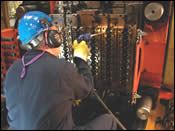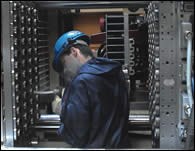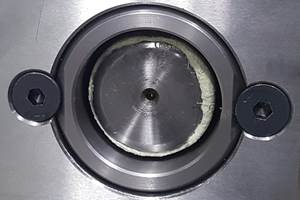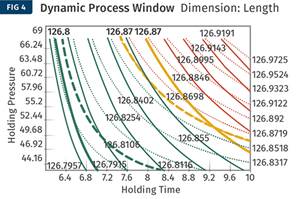Cleaning Molds–Part II Blasting with Dry Ice
Today, the most popular method of cleaning plastic injection molds still remains rooted in the antiquated process of scrubbing tooling and plates by hand, one piece at a time.
Today, the most popular method of cleaning plastic injection molds still remains rooted in the antiquated process of scrubbing tooling and plates by hand, one piece at a time. Ask why, and the answers will be familiar:
- “This is how we have always done it.”
- “We cannot cost-justify other methods.”
- “Other methods do not clean as well” (no bright and shiny surface).
- “Too busy ... no time to experiment or investigate other methods.”
Such excuses cost companies thousands of dollars a day in wasted time and worn tooling. To realize a major reduction in the time required to clean molds, to maximize tooling life, to systemize cleaning and make it more consistent and predictable, hand cleaning must be limited to those areas where it works best, and damages the least.
Hand cleaning
It is a safe bet that hand cleaning will never be eliminated entirely, but it is an enormous waste of time and money to remove, clean, rinse, dry, and replace every piece of tooling in a mold whenever it requires cleaning. Anyone involved with hand cleaning tooling knows already that it is a slow and damaging process. However, hand cleaning can be cost-effective in areas of plastic molds that normally have the most corrosion and contaminant build-up (rust) that is difficult to remove:
- Front and rear clamp plates that directly contact the press platens.
- Bubbler plates (non-stainless).
- Bushings and wear-plate grease grooves.
- Heavy build-ups in water lines (non-stainless).
- Plates subjected to heavy internal condensation and clamp pressure (non-stainless).
Sometimes it is just easier to go with the old, familiar methods than deal with the mayhem of trying to change a mold shop’s “cleaning culture.” I spent many years hand cleaning my own plates and tooling while the company I worked for searched for effective alternatives. It tried different types of spray cleaners, solvents, brushes, etc., but all required handling each piece of tooling several times, which produced no significant cost or labor savings. Even extremely caustic cleaners, such as sodium hydroxide, sulfuric acid baths or MEK, were limited in how much rust build-up they would remove from unplated surfaces in a given time. In the end, I found that the answer to heavy rust build-up is to prevent it through more frequent cleanings, corrosion resistant plating, stainless-steel plates, and consistent use of spray-on rust inhibitors.
Cleaning with dry ice
With the endless variety of resins, molds, and processes being run today, there is no silver bullet for all the different types of fouling and corrosion that attack our molds, whether running or racked. That said, the dry-ice blasting system is quite effective.
Dry-ice blasting is a non-abrasive cleaning method popular among many automotive rubber molders because it can clean molds in the press while the mold is hot and without causing any appreciable secondary waste stream of its own accord. Solid carbon dioxide pellets (about the size of a grain of rice) or shavings (about the size of a grain of sugar) are introduced into an air stream and shot at high velocities through aerodynamically designed nozzles to remove residue quickly and harmlessly from mold plates and tooling.
There are two basic systems used in ice blasting:
- Direct acceleration (single-line hose) system. This introduces ice pellets into the air line at the hopper instead of the nozzle, allowing much faster-moving pellets to exit the nozzle tip at 900 ft/sec (vs. 300 ft/sec for the double-line hose system below). This translates into better cleaning performance. If less cleaning power is needed, simply dial down the air pressure, thus reducing pellet velocity.
- Venturi (double-line hose) system. This pulls or vacuums finer shaved ice particles into the air stream at the nozzle that is directed toward the mold surface. This system is less costly than the single-line hose, but does not generate the nozzle velocities necessary to remove some of the more stubborn residue and grime left on plastic molds.
What are the arguments in favor of dry-ice blasting?
- It’s clean. Ice blasting creates no residual dust or waste stream of its own like all other media blasting units do. Air-quality tests have been performed in cleanroom operations using ice blasting with no measurable effects from the disintegration of the CO2 pellets. The residue blasted off the surface of the mold may collect on surrounding equipment, but you can install air-extraction hoods over molds that generate heavy contamination.
- It’s portable. Small, lightweight units are now available that can be pushed right up to a mold on the bench or in the press, which results in a considerable cost savings vs. bringing the mold to the cleaner. Keep in mind that an air supply will be needed close by (within 20 ft). Standard line pressures of 70 to 90 psi with a 0.75-in. feed line will suffice.
- It’s versatile. Dry ice can be used to clean a variety of equipment other than just molds. It’s effective at cleaning injection screws, barrels, internal mixers, and other equipment—when not needed in the toolroom.
- It has low operating costs. Dry-ice pellets for single line systems cost about 20¢/lb. It takes approximately 20 min to go through 30 lb of ice pellets, which is about how long it takes to clean both halves of a mold measuring 2 x 3 ft. Plan on spending at least $15,000 for a single-line portable unit and a couple of different nozzles.
- It’s easy to use. You will need only a few minutes to familiarize yourself with hooking up the hoses and nozzle and where to load the pellets. Non-abrasiveness eliminates the fear of surface degradation if you move the nozzle too slowly.
So what about the caveats?
- Noise level: At 102 dbA, good ear protection is needed when ice blasting, as with any compressed-air cleaning system. However, even with earplugs, these things are loud and the noise grows more irritating when used for extended periods. It helps to use earmuffs with earplugs.
- Mold safety: Mold plates can blow over and tooling can be launched from bores if proper precautions are not taken or the nozzle tip is misdirected. Plates must be securely braced or lying down. Tooling must be backed up or secured. Do not stack tooling in a basket and blast away.
- Personnel safety: As hunting dads always say, “Watch where you point that thing, son.” That holds true in dry-ice blasting simply because flesh is no match for ice pellets moving at 900 fps. All necessary safety equipment must be worn, including heavy-duty gloves, full facemask, and long sleeves. Because typical workshops have benches and other machines in close proximity (3 to 5 ft apart), be aware at all times of where everyone is located, lest you be accused of violating good shop etiquette through unsolicited exfoliation.
- Rust/residue removal: The non-abrasive nature of dry-ice blasting limits its effectiveness at heavy stain and rust removal. Ice pellets also may be less effective at removing elastic or soft residues left in some natural rubber molding operations—the pellets may tend to bounce off the residues. (However, ice works great at removing LSR–liquid silicone rubber–plate-out, especially on tooling with textured surfaces.) In addition, ice blasters are a line-of-sight cleaning system, meaning you can clean only what you can see.
Dry-ice blasting is best used as an in-press cleaning method, where it can reduce cleaning time and eliminate premature tool wear when compared with the typical wipedown with a solvent-soaked rag and abrasive pad.
(Next month: ultrasonic cleaners.)
Steven Johnson worked as a toolmaker for 26 years, rebuilding and repairing multicavity molds for Calmar Inc. and then as mold-maintenance engineer for Hospira Inc., a medical device manufacturer. Today, he is the maintenance systems manager for Progressive Components and has his own business, MoldTrax in Ashland, Ohio, which designs and sells software for managing mold maintenance (www.moldtrax.com). He can be reached at steve@moldtrax.com or (419) 289-0281.
Related Content
How to Mount an Injection Mold
Five industry pros with more than 200 years of combined molding experience provide step-by-step best practices on mounting a mold in a horizontal injection molding machine.
Read MoreWhat You Need to Know About Leader Pins and Bushings
There’s a lot more to these humble but essential mold components than you might suspect. Following the author’s tips could save much time, money and frustration.
Read MoreHow to Select the Right Tool Steel for Mold Cavities
With cavity steel or alloy selection there are many variables that can dictate the best option.
Read MoreOptimizing Pack & Hold Times for Hot-Runner & Valve-Gated Molds
Using scientific procedures will help you put an end to all that time-consuming trial and error. Part 1 of 2.
Read MoreRead Next
Cleaning Molds: Part I
Cleaning a mold is a critical part of the repair process, but many myths must be dispelled.
Read MoreHow Polymer Melts in Single-Screw Extruders
Understanding how polymer melts in a single-screw extruder could help you optimize your screw design to eliminate defect-causing solid polymer fragments.
Read MoreAdvanced Recycling: Beyond Pyrolysis
Consumer-product brand owners increasingly see advanced chemical recycling as a necessary complement to mechanical recycling if they are to meet ambitious goals for a circular economy in the next decade. Dozens of technology providers are developing new technologies to overcome the limitations of existing pyrolysis methods and to commercialize various alternative approaches to chemical recycling of plastics.
Read More










.png;maxWidth=300;quality=90)




















